
Frank Lloyd Wright was an American architect, designer, writer, and educator.

Monona Terrace is a convention center on the shores of Lake Monona in Madison, Wisconsin.

The Price Tower is a nineteen-story, 221-foot-high tower at 510 South Dewey Avenue in Bartlesville, Oklahoma. It was built in 1956 to a design by Frank Lloyd Wright. It is the only realized skyscraper by Wright, and is one of only two vertically oriented Wright structures extant; the other is the S.C. Johnson Wax Research Tower in Racine, Wisconsin.

Frank Lloyd Wright Jr., commonly known as Lloyd Wright, was an American architect, active primarily in Los Angeles and Southern California. He was a landscape architect for various Los Angeles projects (1922–24), provided the shells for the Hollywood Bowl (1926–28), and produced the Swedenborg Memorial Chapel at Rancho Palos Verdes, California (1946–71). His name is frequently confused with that of his more famous father, Frank Lloyd Wright.

The Darwin D. Martin House Complex is a historic house museum in Buffalo, New York. The property's buildings were designed by renowned architect Frank Lloyd Wright and built between 1903 and 1905. The house is considered to be one of the most important projects from Wright's Prairie School era.
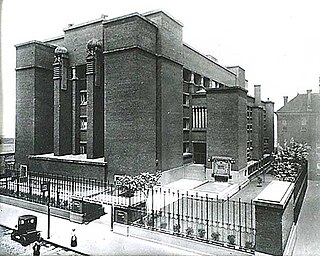
The Larkin Building was an office building in Buffalo, New York, noted for innovations that included central air conditioning, built-in desk furniture, and suspended toilet partitions and bowls. Located at 680 Seneca Street, it was demolished in 1950.
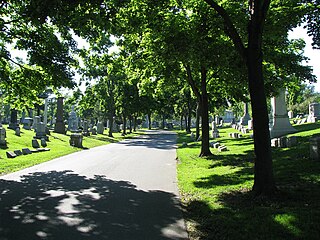
Forest Lawn Cemetery is a historic rural cemetery in Buffalo, New York, founded in 1849 by Charles E. Clarke. It covers over 269 acres (1.1 km2) and over 152,000 are buried there, including U.S. President Millard Fillmore, First Lady Abigail Fillmore, singer Rick James, Congresswoman Shirley Chisholm, and inventor Lawrence Dale Bell. Forest Lawn is on the National Register of Historic Places.

The Grady Gammage Memorial Auditorium is a multipurpose performing arts center at 1200 South Forest Avenue at East Apache Boulevard in Tempe, Arizona, within the main campus of Arizona State University (ASU). The auditorium, which bears the name of former ASU President Grady Gammage, is considered to be one of the last public commissions of American architect Frank Lloyd Wright. It was built from 1962 to 1964.

Pettit Memorial Chapel or simply, Pettit Chapel, is one of the few chapels designed by architect Frank Lloyd Wright. The Pettit Chapel is located in the Belvidere Cemetery in Belvidere, Illinois, United States, which is in Boone County. It was listed on the U.S. National Register of Historic Places on December 1, 1978. The chapel is an early example of Frank Lloyd Wright's famed Prairie style. It is one of only two structures meant for a cemetery setting that Wright ever created.

The Graycliff estate was designed by Frank Lloyd Wright in 1926, and built between 1926 and 1931. It is located approximately 17 miles southwest of downtown Buffalo, New York, at 6472 Old Lake Shore Road in the hamlet of Highland-on-the-Lake, with a mailing address of Derby. Graycliff is sited on a bluff overlooking Lake Erie with sweeping views of downtown Buffalo and the Ontario shore. Graycliff is one of the most ambitious and extensive summer estates Wright ever designed. Graycliff is now fully restored and operates as a historic house museum, open for guided tours year round. There is also a summer Market at Graycliff, free and open to the public on select Thursday evenings. Graycliff Conservancy is run by Executive Director Anna Kaplan, who was hired in 2019.
William Eugene Drummond was a Chicago Prairie School architect.

Darwin Denice Martin (1865–1935) was an early 20th-century New York State businessman best known for the house he commissioned from Frank Lloyd Wright.
Hermann V. von Holst (1874–1955) was an American architect practicing in Chicago, Illinois, and Boca Raton, Florida, from the 1890s to the 1940s. He is best remembered for agreeing to take on the responsibility of heading up Frank Lloyd Wright's architectural practice when Wright went off to Europe with Mamah Cheney in 1909.

Massaro House is a residence inspired by famed architect Frank Lloyd Wright on privately owned Petre Island in Lake Mahopac, New York, roughly 50 miles north of New York city. The design and construction of the house has a complex history, due to the involvement Wright and its high cost. It was initially known as the "Chahroudi House", for the client who commissioned it, but after its completion in 2007 attained the name of the man who bought the designs and funded the construcion, Joseph Massaro. The association of Wright with the residence has been legally disputed by Frank Lloyd Wright Foundation.
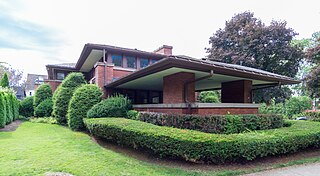
The William R. Heath House was designed by Frank Lloyd Wright, built from 1903 to 1905, and is located at 76 Soldiers Place in Buffalo, New York. It is built in the Prairie School architectural style. It is a contributing property in the Elmwood Historic District–East historic district and a City of Buffalo landmark.
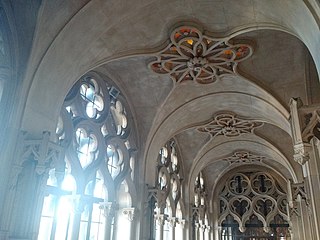
Chapel of the Chimes was founded as California Electric Crematory in 1909 as a crematory and columbarium at 4499 Piedmont Avenue, at the entrance of Mountain View cemetery in Oakland, California. The present building dates largely from a 1928 redevelopment based on the designs of the architect Julia Morgan. The Spanish Gothic architecture features Moorish motifs and the interior is a maze of small rooms featuring ornate stonework, statues, gardens, fountains and mosaics.

The Walter V. Davidson House, located at 57 Tillinghast Place in Buffalo, New York, was designed by Frank Lloyd Wright and built in 1908. It is an example of Wright's Prairie School architectural style. The house is a contributing property to the Parkside East Historic District, a neighborhood laid out by renowned American landscape architect Frederick Law Olmsted in 1876, and also a City of Buffalo landmark.
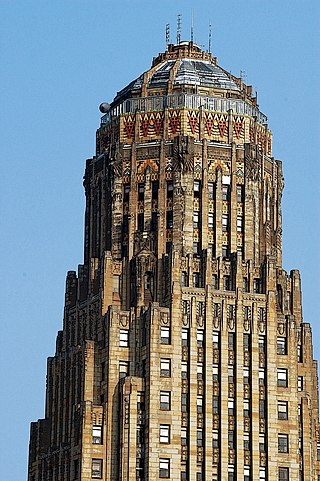
The Architecture of Buffalo, New York, particularly the buildings constructed between the American Civil War and the Great Depression, is said to have created a new, distinctly American form of architecture and to have influenced design throughout the world.
Forest Lawn-Long Beach is a 38-acre mortuary and memorial garden in Long Beach, California, United States. The gardens were established as Sunnyside Memorial Gardens in 1921 by Cecil E. Bryan, Sr., an entrepreneur whose family operated the facility for three generations. Sunnyside was one of the first major cemeteries in Long Beach. Over the years it served the local area, but fell into disrepair by the 1970s. and was purchased in 1978 by Forest Lawn Memorial-Parks & Mortuaries. They renovated the facility, and renamed it Forest Lawn – Sunnyside in deference to its history—later changed to Forest Lawn – Long Beach to match their other properties.

















